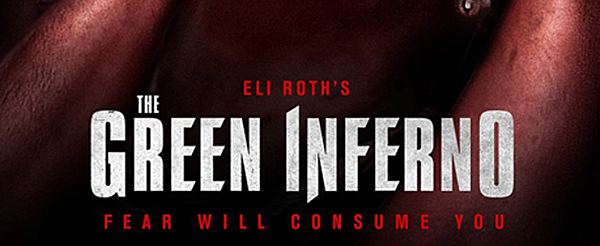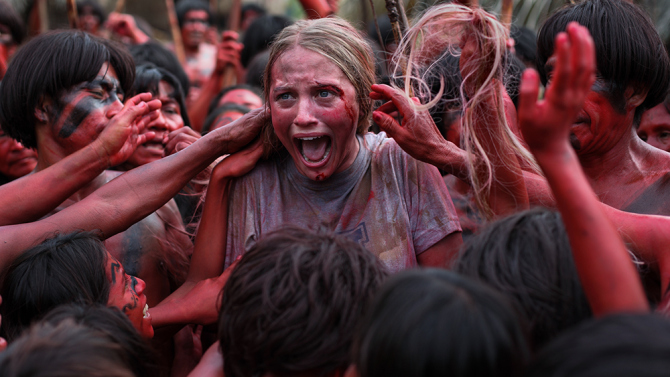For Horror fans, it has been a long time waiting for the release of The Green Inferno, Eli Roth’s gut churning Exploitation flick inspired by one of the most gruesome films of all time, Ruggero Deodato’s 1980 film Cannibal Holocaust. Now the time has finally come for gore lovers to find out what all of the fuss is about as The Green Inferno hit theatres September 25, 2015, finally released through Blumhouse Productions. Roth sent for quite a few of his Aftershock (2012), The Stranger (2014) and Knock Knock (2015) cast and crew, including writer Guillermo Amoedo, composer Manuel Riveiro, and producers Nicolás López and Miguel Asensio, along with actors Lorenza Izzo, Ariel Levy, Aaron Burns, Ignacia Allamand, and Nicolás Martinez. Adding to his group of regulars, Roth called up Oz the Great and Powerful’s (2013) Jonah Levy and Emmy nominated Ozzy Alvarez (The Knick TV series) to create the gruesome special effects and Birdman: Or (The Unexpected Virtue of Ignorance) (2014) producers Molly Conners and Christopher Wood. For acting talent, he brought in Kirby Bliss Blanton (Hannah Montana TV series, Project X 2012), Magda Apanowicz (Kyle XY TV series, Continuum TV series), Daryl Sabara (Spy Kids 2001, Halloween 2007) and Internet sensation Sky Ferreria to round out the cast.
- Still from The Green Inferno
The Green Inferno was mostly filmed on location in rain forests of Peru and Chile, and, during filming, Roth had a one-of-a kind experience with the local natives that he used for his extras. None of them had ever heard of movies, cell phones, or even batteries, and the idea of acting a certain way in front of the weird machine called a camera was a strange concept for them. Roth showed them the original Cannibal Holocaust – whose movie-within-a-movie was actually titled The Green Inferno – and the locals thought the film was hilarious, even offering the crew a living two-year-old child as a thank you for including them in his film. For the director and his crew, they could only hope a show about a village of cannibals was not what they considered a true-to-life comedy. The child, of course, was politely declined.
The wait alone for the release of The Green Inferno has given the movie credibility in its bloody effectiveness. First shown at the 2013 Toronto International Film Festival, the film was then put on hold indefinitely until this past September 25th. If the two year wait was not because of its horrible gore, than what else could possibly hold it up? In fact, filmmakers officially cite financial difficulties with the original production company Worldview Entertainment, but fans still wondered if the notorious director had finally come up with something so horrible that no one would touch it. Being so closely attached to Cannibal Holocaust, a movie banned in over fifty countries, did not help to dispel these rumors.
- Still from The Green Inferno
Right from the start, the movie is unafraid to offend. Within the first five minutes, college Freshman Justine’s (Izzo) roommate, Kaycee (Ferreira), has called activism “retarded” and sees no redeeming value in suffering for a random cause. Justine feels the same way until the girls attend a class on female genital mutilation and Justine realizes that there are causes worth fighting for. Her UN attorney father (Richard Burgi) is no help. Seeing that she may be interested in helping their cause, activist Jonah (Burns) convinces Justine to join his group’s operation to stop a logging company from bulldozing over and ultimately killing off an ancient, indigenous Peruvian tribe. Leading the fight is Alejandro (Levy) and his girlfriend, Kara (Allamand), along with newcomers Amy (Blanton), Samantha (Apanowicz), Lars (Sabara), and Daniel (Martinez).
The crew are smuggled into the South American country by a man named Carlos (Matías López) to live stream footage of the logging company and shame them into stopping the destruction of the tribe. The protest video goes viral, but before they can relax and celebrate, the engine of the prop plane that they are in explodes and they crash into the jungle, right in the backyard of the tribe they had just saved. The red-skinned tribal elders have other ideas, though. They have no idea that these people just saved their lives and their land – they only see the young, Caucasian activists as long pork for their bloody slaughterhouse. Will the revolutionary advocates survive? Or will they become the hungry cannibals’ next meal?
- Still from The Green Inferno
The Green Inferno was well worth the wait. Although the real action takes a bit to get started (the plane does not even crash until the forty-five minute mark), once it gets going, it does not stop. Fans of the blood-soaked Exploitation films of ’70s and early ’80s will love the throwback feel of this morbid, loathsome film. Watchers will squirm in their seats as the straight-faced Peruvian villages skin appendages and roast torsos like last year’s Thanksgiving turkey. The action is furious, spine-tingling, and amazingly fun. Although Rotten Tomatoes’ critics give The Green Inferno a low 37%, genre fans will love the film and its viscous waterslide ride of terror and offal.
Meredith Borders of Birth. Movies. Death. wrote, “The Green Inferno never lets up: it barrels ahead, exuberant and relentless in its brutality, never giving the audience a second to unclench. It’s a feast for gorehounds, one with an unsubtle message about the way that uninformed activism harms more than it helps. And it’s a total fucking blast.” Horror master Stephen King also loved the film, tweeting that it is “like a glorious throwback to the drive-in movies of my youth: bloody, gripping, hard to watch, but you can’t look away.” Who can say that the author of IT and Misery does not know Horror?
Some critics imply that the movie promotes the destruction of rainforests, their hidden villages, and the stereotype that those who live in these tiny hamlets are uncivilized, most notably Survival International, a group that campaigns for indigenous peoples and indigenous peoples living in voluntary isolation. Roth countered with: “The idea that a fictional movie about a fictional tribe could somehow hurt indigenous people when gas companies are tearing these villages apart on a daily basis is simply absurd. These companies don’t need an excuse — they have one — the natural resources in the ground. They can window dress things however they like, but nobody will destroy a village because they didn’t like a character in a movie, they’ll do it because they want to get rich by draining what’s under the village. The fear that somehow a movie would give them ammunition to destroy a tribe all sounds like misdirected anger and frustration that the corporations are the ones controlling the fates of these uncontacted tribes.” Many think the natives that were visited by Roth and his film crew would agree.
Although a sequel for The Green Inferno, titled Beyond the Green Inferno with Nicolás López to direct, was planned back in 2013, the film has now been put on hold after the tough time Roth had with getting the first film to theatres. One can only hope that the success of The Green Inferno will give filmmakers a push in the right direction and encourage them to go forward with this well-awaited sequel. CrypticRock gives The Green Inferno 4.5 out of 5 stars.
- Blumhouse Productions









No comment